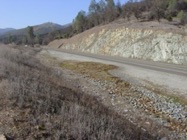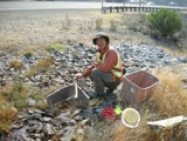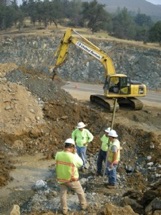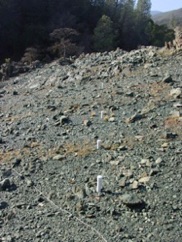The coast range of northern California is composed of many geologically uncommon rock types, including serpentine and greenstone. A deep ground water flow path through the Copely Greenstone allows water to become highly reduced, and to pick up high concentrations of salts. The warm, saline springs discharge perennially in three main areas, and support a unique community characterized by the narrowly endemic grass Puccinellia howellii, whose entire world distribution is these three springs. California state highway 299, which runs from Redding west to Arcata, passes through the spring complexes, and many different highway alignments have impacted the springs and their vegetation. The latest alignment, constructed in 1991 has significantly impacted the spring water flow paths and the site vegetation. The water discharging ranges is nearly as saline as ocean water, and is highly reduced and with high pH. However, as the water flows downslope and sulfide oxidizes to form sulfuric acid, the pH changes from nearly 9 to nearly 5. Issues at this site include alteration of the spring water flow away from the main spring sites, precipitation runoff from the highway to create freshwater plumes that allow the formation of dense Juncus arcticus stands, erosion of sediment from the road, hillslopes and from past road construction, and water seepage from the large areas of road fill which also creates freshwater plumes. Freshwater in this site is a significant pollutant that must be restricted. Our analysis, conducted by Evan Wolf, and myself has included extensive, hydrologic, geochemical, and vegetation analyses, including experiments with transplanted Puccinellia seedlings to determine the hydrologic regime they could survive in. We have also implemented a pilot restoration in the western spring to restore the flow of water from the highway back into the spring complex. The future will bring complete restoration of the middle spring complex by eliminating the flow of freshwater into the spring, removal of sediment that has buried part of the spring, and rerouting an ephemeral stream that has built an alluvial fan in part of the site.



